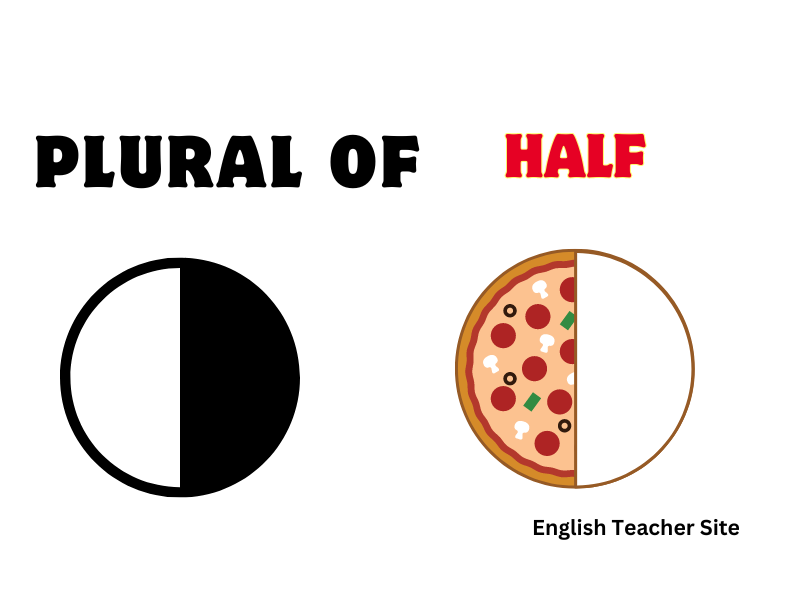What’s the Plural of Half? Understanding Singular and Plural Nouns

- The plural of “half” is “halves,” following a specific rule for plurals of nouns ending in “f” or “fe.”
- Understanding and using the plural form correctly is vital for accurate communication in English.
- “Half” and “halves” can be used in a variety of contexts to express the division of a whole into equal parts.
This transformation turns “half” into “halves,” which is used to refer to more than one portion of something that is divided into two equal or nearly equal parts. Knowing these grammatical nuances is essential for both written and spoken English, as it ensures clarity and correctness in communication. Now, let’s look at how “half” and “halves” function within the context of English grammar, supported by contextual examples to illustrate their use.
What’s the Plural of Half? ½
Singular Form:
- half
Plural Form:
- halves
This change from “f” to “ves” in the plural form is a general rule applied to some nouns ending in “f” or “fe.” Here are two tables demonstrating other nouns that follow this pattern:
| Singular | Plural |
|---|---|
| calf | calves |
| elf | elves |
| Singular | Plural |
|---|---|
| knife | knives |
| wife | wives |
It is important to note that not all nouns ending in “f” follow this pattern. For example:
- roof -> roofs
- cliff -> cliffs
Examples of proper usage in sentences:
- Please cut the cake into equal halves.
- She divided her time into two halves, dedicating one to work and the other to leisure.
Singular Form of Half ½
Examples of Usage in Sentences:
- She drank half a glass of water.
- Half of the pie was missing.
| Aspect | Detail |
|---|---|
| Pronunciation | “Half” rhymes with “calf.” |
| Spelling | “Half” is always spelled H-A-L-F. |
| Usage | Used to express one of two equal parts. |
| Nature | Can describe both countable and uncountable concepts. |
“Half” functions seamlessly within a sentence, pairing with a noun to modify its quantity or scope. Although it might come before a singular noun, it often implies a division into two parts, regardless of the noun’s singularity or plurality.
Grammatical Applications:
- Half of the participants.
- He took half the responsibility.
| Position in Sentence | Example |
|---|---|
| Before a noun | Half a loaf of bread. |
| After a verb | The team split in half. |
Meaning of the Word Half ½
The term half is used to describe one of two equal parts of a whole. When something is divided into two pieces of the same size, each piece is referred to as a half. This fraction is mathematically represented by the symbol ½. In English, “half” can function as a noun, adjective, or adverb, adapting to various contexts in language.
As a Noun:
- Singular: half (e.g., a half of a pie)
- Plural: halves (e.g., two halves of an orange)
As an Adjective:
- Describes something that is cut or divided into two equal parts (e.g., a half portion)
As an Adverb:
- Indicates that something is to a partial extent or degree (e.g., the glass is half full)
The plural form of “half” follows an irregular pattern:
| Singular | Plural |
|---|---|
| half | halves |
When using “half” in a sentence, one may encounter a variety of constructs:
- With Countable Nouns: A half of a grapefruit.
- With Collective Nouns: Half of the committee agrees.
- Time Expressions: It’s half past nine.
Irregular Plural Nouns Ending in -f/-fe and -ves ½
Examples of these irregular nouns include:
| Singular | Plural |
|---|---|
| half | halves |
| knife | knives |
| life | lives |
| wife | wives |
These nouns do not simply add an -s or -es to form their plural. Instead, the -f or -fe ending is removed and replaced with -ves.
In the case of half, the transformation follows the same pattern as other nouns with similar endings:
- calf becomes calves
- leaf becomes leaves
- Dwarf: dwarves or dwarfs (both are correct, but dwarves is more common in fantasy contexts)
- Loaf: loaves
Contextual Examples of Half (in Sentences) ½
Simple Sentences:
- She drank half of her coffee before leaving for work.
- He completed the task in half the time expected.
Compound Sentences:
- The group decided to split the winnings in half, and each member walked away content.
- She spent half the day reading, and the rest she dedicated to writing.
Tables Demonstrating the Usage of “Half”:
| Context | Sentence Using “Half” |
|---|---|
| Time | They agreed to meet in half an hour. |
| Quantity | Only half the students attended the lecture. |
| Distribution | Sentence Using “Half” |
|---|---|
| Division | I sliced the pizza into half for us to share. |
| Comparison | His new car cost about half as much as mine. |
- When referring to division:
- She gave half her sandwich to her friend.
- In descriptions of proportions:
- Half the room was painted blue, creating a stark contrast.
Complex Sentences:
- Despite eating only half the pie, he felt as if he had overindulged.
- Given that half the project is complete, they anticipate finishing earlier than scheduled.
Contextual Examples of Halves ½
Instances in Measurements:
- When splitting an apple, one might divide it into two equal halves.
- A standard basketball game consists of two halves.
Mathematical Usage:
- In a fraction, if a pie is divided among four people, each person gets two halves of a half, which is mathematically expressed as ½.
Financial Terms:
- Stock splits often result in shareholders receiving two halves for every share they owned before the split.
Physical Objects:
- When a piece of wood is sawed into two parts, each is called a half; together, they are known as halves.
Singular and Plural in Measurements
| Singular | Plural |
|---|---|
| A half kilogram | Two halves of a kilogram |
| Half a meter | Three halves of a meter |
Singular and Plural in Objects
| Singular | Plural |
|---|---|
| Half a pizza | Four halves of pizzas |
| Half a sandwich | Six halves of sandwiches |
Synonyms of Half ½
- Moiety: This term emphasizes a portion that is one of two equal divisions.
- Fraction: Generally used in mathematics, it refers to any division of a whole.
- Semis: Although not commonly used, it also means one of two equal parts.
| Synonym | Contextual Usage |
|---|---|
| Moiety | Legal, or formal documents and discussions |
| Fraction | Mostly in mathematics and science |
| Semis | Infrequently used, applicable in formal text |
In literature, these synonyms can bring variety and specificity to text. Consider the following list for instances where a choice of words can enhance the quality of expression:
- Portion: Implies a part allocated to someone or something.
- Division: Suggests a section of a larger item or group.
Origin of the Word Half ½
Tracing the etymology of ‘half’ reveals an intricate tapestry woven from the threads of language evolution. The term itself finds its roots in Old English, documented as ‘healf’, and it shares lineage with the Old High German ‘halp,’ both meaning a part of something that is divided into two. Structurally and conceptually similar, ‘half’ is a term that has been denoting equal division for centuries.
The semantic journey of ‘half’ is punctuated by noteworthy Old Norse influences, evident in the Old Norse term ‘halfr.’ This interlingual exchange shaped the word’s transmission into Middle English, where ‘half’ found a stable orthographic form.
| Old English | Old High German | Old Norse | Middle English |
|---|---|---|---|
| healf | halp | halfr | half |
The Proto-Germanic ‘halbaz‘ has been identified as a potential ancestor, tying ‘half’ to even more ancient linguistic roots. It emerges as a word knitted into the framework of the Germanic family of languages, exemplifying the shared heritage and connections between these tongues.
Conceptually, ‘half’ extends beyond mere division, often symbolizing wholeness and balance by its very nature of bisecting unity. Understanding ‘half’ necessitates recognition of its duality — as both fracture and completion.
- Representations of ‘Half’:
- Component of a whole
- Symbol of equality
- Metaphor for balance
Through centuries, ‘half’ has maintained its fundamental meaning while adapting to the phonetic and cultural changes within the English language, showcasing the resilience and flexibility of linguistic forms. It stands testament to the organic evolution of words across time and culture.
Sources
My name is Khamis Maiouf. I am the creator of the English Teacher Site, dedicated to providing valuable resources and insights for students around the world. With a passion for education and a commitment to helping students enhance their skills, I aim to make English teaching more effective and enjoyable for both educators and students.






